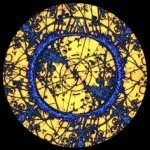Blogs
Our community blogs
-

- 13
entries - 40
comments - 2004
views
Recent Entries
 Latest Entry
Latest Entry
Moog's Polyphonic Theremin
Moog is the leading producer of synthesizers in the world, I would guess. For every concert i have been too, the staple instruments for the piano player are a hammond B3 organ (with the leslie speaker ofcourse), and one or more Moog brand synthesizers.
Well, we all love the theremin, and Moog just created the first polyphonic theremin. Many have tried, and all but Moog has failed. Apparently, when you put 2 theremins in the same room, they dont work, or you get alot of feedback with eacher, but Moog figured out how to make them work together. Check it out!!
- 13
-

- 30
entries - 19
comments - 28559
views
Recent Entries
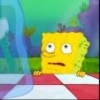 Latest Entry
Latest Entry
Geometry Simplifies Quantum Physics
 In December of 2013 physicists discovered a way to approximate the amplitude of scattering sub-atomic particles in a way that is much, much simpler than the old method. The idea is that given a set of parameters and whatnot, a geometric object, which is being called an amplituhedron, can be constructed such that it's volume equals the amplitude of a scattered particle from a quantum interaction. The old method involved using hundreds to millions of Feynman diagrams, which show possible ways the particle could scatter, and summing the probability of each situation occurring. Even a simple interaction had to be modeled by a formula several billion terms long but the amplituhedron process reduces that to just a few pages of work. For example, the diagram to the left represents an 8 gluon particle interaction. If the same calculation were to be done with the Feynman method it would involve around 500 pages of calculations. The implications of this are enormous, and this may be a big step in the direction of a functional unified field theory.
In December of 2013 physicists discovered a way to approximate the amplitude of scattering sub-atomic particles in a way that is much, much simpler than the old method. The idea is that given a set of parameters and whatnot, a geometric object, which is being called an amplituhedron, can be constructed such that it's volume equals the amplitude of a scattered particle from a quantum interaction. The old method involved using hundreds to millions of Feynman diagrams, which show possible ways the particle could scatter, and summing the probability of each situation occurring. Even a simple interaction had to be modeled by a formula several billion terms long but the amplituhedron process reduces that to just a few pages of work. For example, the diagram to the left represents an 8 gluon particle interaction. If the same calculation were to be done with the Feynman method it would involve around 500 pages of calculations. The implications of this are enormous, and this may be a big step in the direction of a functional unified field theory.
- Read more...
-
- 0 comments
- 30
-

- 8
entries - 20
comments - 1898
views
Recent Entries
 Latest Entry
Latest Entry
Home Brewed Physics Simulation
As a little programming project, I am working on a basic physics engine that is intended to eventually handle spherical particles, walls, and springs. Currently, I only have particles that are fully functional. This is an open-source project and it is hosted at http://code.google.com/p/simple-swing-physics-sim/.
- Read more...
-
- 0 comments
- 8
-

- 31
entries - 23
comments - 20448
views
Recent Entries
 Latest Entry
Latest Entry
College?
 What's this? New AP-C students?
What's this? New AP-C students?Welp a new dawn has... dawned and I have made the short stroll of 18 miles to RIT. So what has changed? Not much.
Right now you AP-C'ers are taking, I assume, mostly college level courses and believe it or not they are actual college level classes, like no joke. With Calculus, Physics and other classes I was (and you are) taking the equivalent of a Freshman year in college. If it sounds intimidating its because it is, taking that big of a step a year early is very tough and will, at points, seem like the worst decision of your life.
Don't get me wrong senior year is lots of fun, but remember, if a class like Calc or Physics is getting you down, hold on. At some point or another you will have to realize that not all knowledge is easy to learn and high school is the best place for that. Mr. Fullerton is amazing and he, unlike a college professor, will help you through every step if he needs to.
Enjoy yourself and
make it a great year!
Oh yeah, READ THE TEXTBOOK (I have to pay for mine, use it while it's free)
Have fun and stay classy,
Shwiby
- 31
-

- 30
entries - 13
comments - 9817
views
Recent Entries
 Latest Entry
Latest Entry
The Observer Effect
The observation of interactions is basically the foundation of science and physics, but often times this observation directly alters the phenomena being observed. This concept is aptly named the observer effect.
In circuits, the voltage and current can be measured by the use of voltmeters and ammeters, respectively. However, the placement of these devices into the current alter the actual voltages and currents of these circuits. This is why voltmeters are very high in resistance and wired in parallel, and ammeters are very low in resistance and wired in series. This is to minimize the essential error or alteration they are causing, and since there is really no "zero" or "infinite" resistance, these errors will just have to be diminished by improving technology, though obviously we have come very far in this respect.
There are other examples, such as measuring temperature with a thermometer. The thermometer slightly changes the temperature of the liquid it is placed in. Also, electrons are detected by using photons, and this interaction alters the path of the electron.
This is often confused with Heisenberg's uncertainty principle in quantum physics, so I'll mention that briefly. Basically, the precision of a pair of physical properties of a particle (complementary variables) can be expressed as an inequality.

Here, x and p are position and momentum. As the precision of one gets higher, the precision of the other gets lower, and this relationship can be expressed as a fundamental limit using inequalities.
- Read more...
-
- 0 comments
- 30
-

- 4
entries - 14
comments - 1904
views
Recent Entries
 Latest Entry
Latest Entry
Application of Oskillation
Trying to think of a new topic about which to blog I somehow remembered seeing this video and thought it only appropriate after finishing the unit on oskillaiton. Inspired by the Tacoma Bridge collapse (1st video) Shawn Frayne designed a small wind generator that uses an oskillating tensioned belt to generate energy from the wind (2nd video).
http://www.youtube.com/watch?v=IqK2r5bPFTM&feature=related
http://www.youtube.com/watch?v=IqK2r5bPFTM&feature=related
http://www.popularmechanics.com/science/energy/solar-wind/4224763
In 10mph of wind the design produced an output of about 40 milliwatts (true facts) and assuming the system is perfectly efficient, has an amplitude of about 2.5cm, and a belt with mass 4g (these are just assumptions) we may be able to find the frequency of the oskillating belt.
Let's gather some formulas:
We have power and P = W/t
W = ΔKE
When the belt passes through equilibrium Etotal = KE = (1/2)mv^2.
vmax (which occurs at equilibrium) = Aω
ω = 1/T
T = second/cycle
Now if we put them together, focusing on the time t it takes the belt to travel from the amplitude to equilibrium (T/4) we can say that:
P = [(1/2)m(Aω)^2 - 0] / (T/4)
P = 2m(A^2)(1/T)^3
T^3 = (2mA^2)/P
T^3 = 2(0.004kg)(0.025m)^2/(0.040W)
T^3 = 0.000125s^3 (It's always a good sign when your units work)
T = 0.05s
Furthermore, with f = 2π/T we get a frequency of about 126 Hz.
Considering that much of the energy of the belt is lost we can assume that to produce the same milliwatts it oskillates much faster meaning a smaller period and a faster frequency.
- 4
-

- 10
entries - 11
comments - 5460
views
Recent Entries
Latest Entry
Physics, Physics, or Physics?
Originally this post was going to be written as a play and emulate shakespeare but it's so hard to use blank verse and iambic pentameter when words like acceleration take up half the steps per line, It's as if physics wasn't designed to be performed by a theater troupe I mean seriously Newton? Where's your artistry bruh bruh? Needless to say my original plan failed rather colossally so I'm just gonna present the gist of what the play would have been and break down the physics behind it. The curtains open to a library where leibniz and newton are having a heated debate over the credit for that whole weird calculus thing. Keep in mind it's a library so all of this happens with a minimal volume. The argument escalates rather violently and the two draw up arms. While they fight they literally shout-whisper out the physics and calculus of what their doing. Lines like "i strike thee with a great velocity"or "thou shall cease to have energy kinetic nor potential!"
Anyway the play will be funny when i finish it for my blog next quarter. But for now I'll discuss the physic of two calc geniuses beating each other silly. You see each time one hits the other their built up momentum that goes with their punch becomes a major impulse delivering a huge force in minimal time, performing work on things like newton's teeth when their position is rather drastically shifted. When they presumably throw the library books at each other the projectile motion has to be accounted for, the velocity of a book thrown by newton will hit leibniz with a great reduction due to drag forces and the acceleration due to gravity.
- 10
-

- 33
entries - 19
comments - 23857
views
Recent Entries
 Latest Entry
Latest Entry
The AP(s) are OVER!
Did I just get hit with a dump truck or did I just take the AP Physics C exams? Turns out, I took the exams.
Yes, they're over....and with a massive sigh of relief, I can move on with my life and enjoy the rest of my senior year.
But I must be honest...they were the hardest exams I have ever laid my eyes on, and it came as a wake up call to me that, yes, maybe I DO have to work harder in future physics courses.
This year in physics, although rough academically, taught me that one cannot simply understand a concept with ease at this level (with a few exceptions...)
So as I move on with life, I will take physics at RIT at least knowning what to expect, and I'll have a working knowledge of the basics.
But seriously, those exams hit me like a truck. And the truck had spikes and chainsaws in the front. Yes, it was pretty violent.
- 33
-

- 23
entries - 37
comments - 3617
views
Recent Entries
Latest Entry
Musing
I can already tell this post will have a lot less structure than usual.
I've been thinking about special relativity quite a bit more than usual these past few days, in particular, the twins paradox. We didn't discuss it, but it seems to me that the actual aging is not the paradox involved, but the question of which twin aged how much is the paradox, since the earth twin would believe the other twin to be 40 years older and the space twin would think himself only 4 years older. Secondly, we discussed that special relativity applied to objects either in constant motion or at rest. In other words, objects in an inertial frame of reference.
That being said, the brother traveling in the spaceship must have experienced some sort of acceleration throughout his journey, when he left earth for example, and most likely when he turned around and when returned to earth. Therefore, I do not even think that the laws of special relativity apply to this situation. The question then for me is in that situation what would happen?
I imagine that the twin on earth has aged physically by forty years and that the twin who traveled has aged physically by just four years, and that no paradox exists at all.
Something else I have been thinking about: E=MC^2
I never truly understood the principle, so I looked online for the experiment used to determine this formula, and then attempted to derive it myself. I found that a useful experiment to reference (although theoretical) is this: a box is stationary in a vaccuum. A photon moves through the box from left to right. Since a photon technically has momentum, the box must then move left in order to conserve momentum of the system. When the photon reaches the right side of the box, the impact causes the box to stop moving.
However, since no external forces acted on the box, its center of mass must be in the same position as before (new concept for me!) but the box has moved left. Therefore, Einstein determined the photon must have a mass equivalent in order to satisfy the laws of physics.
I dreged up an equatin devised by Einstien to get started. I wonder if he came up with this expression before or after he determined that E=mC^2, because that would make this post seem rather silly. Since, a photon is massless, I was able to draw a simpler conclusion from his equation.The momentum rho is the momentum of both the box and the photon, by conservation of momentum.
Running low on ideas, I nosed around some more, and found that I should start thinking about the time it takes the photon to move from side to side. That train of thought led me to the following. The key is that velocity is change in displacement over time and that the time the photon required to cross the box is the length of the box side over the photon's velocity.
Thanks to what I learned this year in class, I know the center of mass of a system can be expressed the sums of products of mass and displacement of all individual parts over the sum of all individual masses.
I determined that if the center of mass did not move, then the position of the center of mass must have been in the same position as the box after the system resolves itself.
We can substitute X2 (the displacement of the photon) to be L the length of the box because it traveled the full length of the box.
Reviving the previous equation created and substituting it for m(delta x):
(I can do this because although the expression reads differently, the displacement after represents the displacement of the photon after colliding with the box's side, and the Mass is of the same object in both cases)
I find that deriving an equation always helps me to conceptualize it, and I hope this derivation helps you too! In my probing I also discovered that all mass has a measurable frequency, although it has little or no effect on people. More on that later...
- 23
-

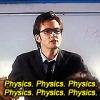 Latest Entry
Latest Entry
Scorpion Season 1 Episode 8: "Risky Business"
It's everybody's favorite physics problem: the elevator! One does not learn mechanics without encountering the elevator problem (as far as I know). This is an interesting, sort of different take on it though.
I'll be honest, the first I saw this I had no idea why Walter and Toby were tying their belts to the elevator bars. But it all makes sense about 5 seconds later when a rather...well....happy Happy stopped the elevator very suddenly. The belts looped around their arms and the elevator bars keep the duo from a painful collision with the ceiling of the elevator, a fate their captors cannot avoid. By why do they slam into the top of the elevator when its acceleration is downward, why don't they hit the ground instead?
Let's start with what we know about elevators.
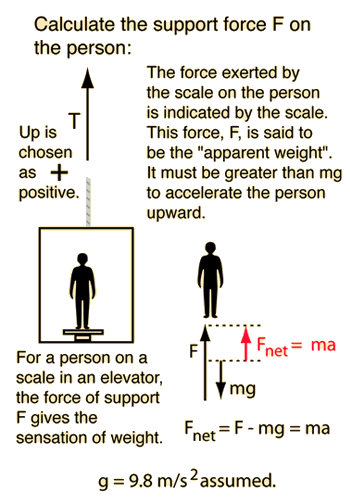
So this is pretty nifty! We are looking at the "accelerating downward" one. What we know is that while the elevator accelerates downward, the net force on the person is actually upward. This occurs due to the support force of the cable holding the total weight of the person and the elevator. We know from this that the net force (F=ma) on the person is total support force minus the force of gravity on the system. Therefore the net force on the person is less than their actual weight (thus the idea of weighing less in a downward accelerating elevator). What does this have to do with our problem from the episode? Well, we know from looking at this that person doesn't actually float (as much as I'd like that to happen) when the elevator moves down, but the contact force between the person and the floor of the elevator has lessened since the normal/net force on the person is less. Now we bring in the idea of inertia. The human body, in this case will want to stay at rest with in the elevator, so we are not seeing the people accelerate upward but rather the their bodies attempting to stay in place the elevator floor "falls out" from under them (so to speak). Their bodies will attempt to remain still as the elevator moves downward in short bursts and thus they are thrown into the ceiling. Well, Walter and Toby aren't, they have their belts. Although, I do wonder how they did not break an arm or something.
Anyways, that's all I've got to say, so thanks for reading!
-

- 30
entries - 29
comments - 17419
views
Recent Entries
 Latest Entry
Latest Entry
Physics of Parkour: The Top-Out
 I attend the local Rochester parkour gym (http://www.rochesterparkour.com/) on a weekly basis. I also tend to struggle to come up with topics for my physics blog posts. But today, I had a revelation: why not combine the two. So I introduce my new series, the physics of parkour. First up is the "top-out".
I attend the local Rochester parkour gym (http://www.rochesterparkour.com/) on a weekly basis. I also tend to struggle to come up with topics for my physics blog posts. But today, I had a revelation: why not combine the two. So I introduce my new series, the physics of parkour. First up is the "top-out".A top-out is essentially a way to go from a hanging position on a ledge (a "cat"), to having your upper body above the ledge with your palms supporting you, without clambering up with your elbow in between. Here's a mock up of it:
And a video (if you only want to watch the top-out, and not all the instruction, you can go to 5:12):
It relies on three things: a solid footing, a good knee drive with the hanging leg, and of course maintaining a solid grip with your arms. When done properly, it requires a lot less upper body strength then you might imagine.
For a brief overview, it consists of three parts: building upwards momentum with your legs, building a bit of forward (but mainly rotational) momentum with your arms (the reason why they play more into rotation more than anything will be discussed), and finally transitioning to the support position resting above your palms. First, and most important, is the legs. One is planted firmly, and the other is supposed to drive upwards, in order to build momentum which will later be transferred to the rest of your body. However, friction can be tricky: the tendency of your planted leg is to slip and slip, because most people will "paw" at the wall as if they were running up it. As we know, frictional force is proportional to normal force, so you actually want to kick/jab your foot into the wall, because this will allow it to stay in place. As you're doing this, you can drive your hanging leg up, generating some momentum.
During this, you should also be pulling up/in with your hands. Simply, you want to counteract/overcome the force of your leg pushing away from the ledge, and also gather a bit more upwards momentum. However, simply due to the weaker nature of our arms, it won't contribute quite as much as our legs, which can be surprising. What is helpful, though, is the torque it creates on the body: while it is counteracting the linear momentum from our legs, it is working with the force from our legs to rotate our body over the lip, which is more beneficially, seeing as we right next to the wall to begin with. Now, with momentum built up from our knee drive and arms, and a slight rotation, our upper body will pop up and over the ledge, and rotate us into a position where we can easily re-position our hands to rest on our palms.
From there, it is usually pretty easy to swing/climb up the rest of the way. But without proper training, this technique is very difficult, because people usually rely on their arms way too much. Yet again, it's an example of something made easier through physics.
- 30
-

- 5
entries - 21
comments - 17602
views
Recent Entries
 Latest Entry
Latest Entry
Alice in Wonderland & Modern Physics
 The Quantum Physics of Alice and Wonderland
The Quantum Physics of Alice and WonderlandLewis Carroll had some interesting ideas in his works, especially in Alice in Wonderland. Alice falls asleep in a meadow, dreams of plunging through a rabbit hole, then finds herself too large and then too small. She meets new and bizarre characters on her way as well, including the Cheshire Cat, the Mad Hatter, the March Hare, and the King and Queen of Hearts. She experiences wondrous, often strange adventures, trying to reason in numerous discussions that do not follow the usual paths of logic. Finally she totally rejects the dream world and wakes up. This book almost mirrors the theories of quantum physics. Things in extremes: things too small and too large. Just like the tiniest particles you can think of--quarks and electrons--and the biggest thing you can think of-- galaxies, black holes, and more recently discovered, the Large Quasar Group.
http://www.livescience.com/23232-smallest-ingredients-universe-physics.html
http://www.huffingtonpost.co.uk/2013/01/14/quasar-cluster-largest-object-einstein_n_2470562.html
Quantum disobeys many theories in classical physics. Especially many of Newtons claims, and now even Einstein's. It reveals laws which could have the slightest bit of chaos to change entire equations already used in classical physics and logic. Alice does crazy things that would not have normally been seen as proper or normal. She gets really big, then small, falls into rabbit holes, talks to cats... And, everything in physics is about a cat as we all know, and the Cheshire Cat explains to Alice that everyone in Wonderland is mad, including Alice herself, hence it must be right. The Cheshire Cat gives directions to the March Hare's house and fades away to nothing but a floating grin. Cats can do everything. They can be alive, be dead, be alive and dead (vampire cats), not in a box, in a box, or floating in mid air with only its teeth showing.
Many things in Alice in Wonderland are illogical or just confusing and weird, this is all you need to know about quantum physics. The mallets and balls in a game of croquet (in this wonderland) are live flamingos and hedgehogs. And there are illogical laws much like in quantum physics with the Queen frantically calling for the other player's executions. Amidst this madness, Alice bumps into the Cheshire Cat again, who asks her how she is doing. Obviously some cats worry. But the King of Hearts interrupts their conversation and attempts to bully the Cheshire Cat, who impudently dismisses the King. The King takes offense and arranges for the Cheshire Cat's execution, but since the Cheshire Cat is now only a head floating in midair, no one can agree on how to behead it. In the Schrodinger's cat, there is a cat enclosed in a chamber with a vial containing hydrocyanic acid, a radioactive substance. If even a single atom of the substance decays during the test period, a relay mechanism will trip a hammer, which will, in turn, break the vial and kill the cat. The Copenhagen interpretation of quantum mechanics implies that after a while, the cat is simultaneously dead and alive. (This is all in theory.) So similarly, in this case, no one can decide whether the cat is both dead and alive, or either dead or alive in this wonderland, no one can decide how to behead the cat.
Alice's wonderland is much like the theories and laws of quantum physics. There could be the most structured laws in physics, but the tiniest bit of randomness occur in quantum physics which causes much stress, chaos, and a lot of calculus for scientists and science itself. Such complex theories and complex and imaginary numbers make this wonderland of physics. I can understand how Carroll, being a man of mathematics, could make such a book. Mathematics is so literal and straightforward, and makes you a little mad. Some theories make you wonder whether we are existing at all, and whether time is real. Math can make you crazy just by trying to explain how 1 is larger than 0, or how to describe a straight line in 20 pages.
Alice in Wonderland is a book which has underlying tones of reality and debate over many theories of quantum physics. This does not surprise me because Carroll was a rather exceptional student of Oxford, where he studied mathematics and was great at Aristotelian logic. The author's life and work has become a constant area for speculation and his exploring of the boundaries of sense and nonsense which has inspired a number of psychological studies and novels.
They are against Alice's common sense: 'I can't believe that!' said Alice. '... one can't believe impossible things. But the White Queen has her own principles: "Why, sometimes I've believed as many as six impossible things before breakfast.' (from Through the Looking Glass) Which is possible...and impossible! Everything, anything and nothing may and may not occur in quantum physics, but above all, only some of it is in theory, the rest is true, and there is proof and evidence backing it all up. As for Alice in Wonderland, that�s up for you to decide.
http://www.npr.org/2010/11/12/131274183/the-spookiness-of-quantum-mechanics
- 5
-

- 40
entries - 55
comments - 14942
views
Recent Entries
 Latest Entry
Latest Entry
MY LAST BLOG POST D:
Soooo, because this is my last blog post for this year (
 ), I thought it would be fitting to do a course reflection on the AP-C physics class this year. I thought I'd do it in a "bests-vs-worsts" top 5 format, kind of like you could find on collegeprowler.com when viewing different schools.
), I thought it would be fitting to do a course reflection on the AP-C physics class this year. I thought I'd do it in a "bests-vs-worsts" top 5 format, kind of like you could find on collegeprowler.com when viewing different schools.Top 5 Bests:
5.) Blog Posting [i thought this was really fun! I've never done anything like this before for a class. It brought up interesting physics applications and I thought it was fun to converse with classmates on the site
 ]
]4.) Independent Units [As uncomfortable as I was at first, independent units forced me to manage my time, work harder than usual to learn the topic, and was great preparation for college. I feel like everyone sould experience this kind of a unit before graduating]
3.) Assigned practice problems from the readings [Assigned problems were REALLY helpful. I would've struggled a lot more than I did had I skipped doing the sample problems]
2.) Units with Lecture & book follow-up [This is my favorite way to learn things! The read-then-lecture method]
1.) VIDEOS <3 [Hands down the most helpful resource in Physics]
Top 5 Worsts:
...I think this is my biggest beef. I really don't have 5 things to complain about.
1.) Readings weren't assigned [When life gets busy in the middle of the year, especially with a number of APs, sports, etc., readings are the first thing to get cut out for me if they're not assigned. Confession: when the going got tough, I would often skim or not read. I reccomend assigning readings in the future. Kids will complain, but they'll thank you when they see better grades and their AP score.]
Overall, this was a successful year. A note to future students: This is by far the hardest AP course I've taken throughout high school. If you want to succeed, you must:
A.) Read the textbook and do some practice problems
B.) WATCH THE VIDEOS. Whether you're confused or simply want review, these are soooo outrageously helpful. It's like being in class a second time, except in 15 minutes or less instead of 42. Plus, you can skip over any sections that you feel you know solid.
C.) REVIEW THE EQUATIONS AND FREE RESPONSE BEFORE THE AP. I went through most of the E&M free response questions as well as both E&M and mechanics equations before the exam. KNOW THE EQUATIONS! I swear equations and key concepts are the majority of the test when it comes to the multiple choice Qs.
Any favorite parts of the year? Things you wanted to change? Post below with your opinion!
...I can't believe we only have 1 more day of physics

- 40
-

- 31
entries - 17
comments - 10761
views
Recent Entries
Latest Entry
Physics of a clock
At this point I am so beyond tired that all I can think about is the time, hence the physics of a clock blog post idea. However just as i became so tired that this idea popped into my mind and I became outrageously enthused and will make this a wonderful thirtieth blog post!!
There are many methods of operation clocks utilize. These are the spring loaded, pendulum/weight powered and even more modern clock variations which i will explain later. Most of the modern clocks now utilize these next few methods for keeping time. All but the quartz watchs use a device known as an escape mechanism. This escape mechanism serves a very inportant purpose because it regulates the forces applied to turn the clock gears in such a way that they move only a certain amount per second. Regardless of its type, each click has this crucial escape mechanism. The escape mechanism works by transfering the force driving the gears to turn (whether it that force is caused by trasfering the gravitational force from a weight or the force transformed from battery power) into an oscillating mechanism which could be in the form of a pendulum, a spring, or a verge-and-foliot. The oscillating pieces work as the clock's counting mechanism and through the use of gears, the clock is able to keep accurate time.
A spring loaded clock utilizes the potential energy stored in a wound spring to turn gears that are then stopped and restarted by the escape mechanism which makes the movements of the watches hands move at a certain rate. The main disadvantage of this type of time keeping device is that the spring needs to be wound up periodically or else the resulting placement of the hands will be inaccurate.
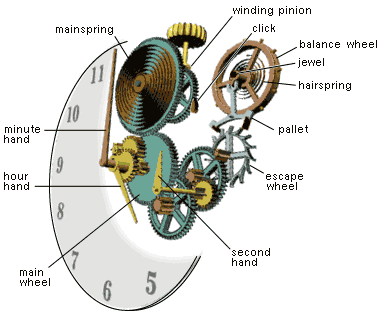
The second type I will discuss is the pendulum, also known as the weight powered design. Unlike the spring loaded clock mentioned above this type utilizes the potential energy from a hanging weight to turn its gears and a pendulum assisted escape mechanism to give the clock a certain periodicity. The assisted escape wheel, similarly to the spring loaded clock, has a specific frequency at which it travels which aids in the accuracy of the clock. But unlike the spring loaded clock, a weight driven mechanism keeps more accurate time because it faces less error when the weight gets close to needing to be reset.

- 31
-

- 30
entries - 20
comments - 11565
views
Recent Entries
Physics is.. so gosh darn great
I feel like it and I... are fate.
With a Newton here, or a Pascal there,
These SI units we love and share.
Whenst look for a potential mate,
All emotions to physics, they equate.
If the air in the room feels perhaps electric,
Just know that physics isn't eclectic.
A standard mix of fun and function,
Studying physics fills one with compunction.
Alas, alack, it is time to go,
I'll need to do work, that's fo' sho'.
As Bernoulli said, just go with the flow.
So shine like a lumen and simply glow.
- 30
-

- 13
entries - 7
comments - 3663
views
Recent Entries
 Latest Entry
Latest Entry
Feynman
I was doing a little research this past weekend on Richard Feynman and came across a speech that he gave at a meeting of the American Physical Society in December of 1959. Of course, Feynman did many great things but I want to focus solely on this speech which basically foreshadows the amazing things that we would be able to do with nanotechnology. You can read a copy of the speech here, http://www.zyvex.com/nanotech/feynman.html , but I thought I would point points that were most memorable to me. Feynman discussed the concept of writing 24 volumes of the Encyclopedia of Brittanica on the head of the pin. He announced that it would be possible if it is demagnified by 25,000 times and each dot is readjusted by photoengraving. In order to read this small print, we would have to make a mold of the lettering and evaporate gold at an angle so that the little letters will appear clearly in a silica film under an electron microscope. If all 24 million books throughout the world were placed onto pinheads, they would use up the area of about a million pinheads. I thought it was very interesting that although we wouldnt be able to read off the head of a pin, we could send books with little effort to devastated countries and underdeveloped nations. It is incredible to think that over 50 years ago, someone thought of this and to compare this idea with the progresswe have made through the years in nanotechnology.
A very promising lead that emerged from Richard Feynman’s speech was the ability to write on a small- scale. In 1990, the image of atomic manipulation caused quite an uproar. In 1981, scientists developed the scanning tunnelingmicroscope to assist them in seeing single atoms clearly.(Keiper) The image, spelling out “IBM” in just 35 atoms, was created out of xenon atoms and was just the beginning of new advances. By picking up and placing atoms in a desired location, scientists broke through to another new level. Feynman’s speech predicted that this would be possible, as he couldn’t see why it wouldn’t work. Feynman was definitely before his time with many of the topics addressed in his speech but for this particular one, it may have been just what the world needed to get off on the right foot in research and development.
Sorry that's so long and boring; I found it interesting

[ATTACH=CONFIG]387[/ATTACH]
- Read more...
-
- 0 comments
- 13
-

- 30
entries - 10
comments - 10248
views
Recent Entries
 Latest Entry
Latest Entry
On a Lighter Note...
 Just like how mirrors are colorless and have a color, black holes are TITLED black and do not have one. Fzx obviously didn't go to kindergarten.
Just like how mirrors are colorless and have a color, black holes are TITLED black and do not have one. Fzx obviously didn't go to kindergarten.So I thought I'd just go through this black hole phenomenon real quick because I personally find it super interesting. And now: a brief summary of black holes and radiation...
Black holes are NOT black! Not in the least. They glow. Black holes glow slightly and give off light throughout the whole spectrum! This includes visible light.
This form of radiation is dubbed "Hawking radiation" after the famous professor Stephen Hawking. He was the first to propose this (legitimate) theory.
Black holes are constantly giving off this glow and therefore losing mass. Ergo, unless another source of mass (such as interstellar gas or light) sustains them, a black hole will eventually evaporate altogether! Smaller black holes, in theory, emit radiation a lot faster than larger ones...so as predicted, if the Large Hadron Collider creates miniscule holes through particle collisions...they should evaporate almost immediately!
In this way, scientists should be able to study a black holes' decay through radiation and learn much more about the how's, why's, and find answers to some of our most ominous, universal questions...
Leading us to a much...brighter...future(;
- Read more...
-
- 0 comments
- 30
-

- 40
entries - 37
comments - 16096
views
Recent Entries
 Latest Entry
Latest Entry
My Last Blog Entry
In early September, in the very beginning of my time in AP Physics C, I was hesitant about the workload and difficulty of the course. When Mr. Fullerton introduced integrals to us for the first time, I knew from then on that the class would be no piece of cake. The funny thing looking back is that I enjoyed the calculus parts of physics by the end of the year very much. With a solid calculus background, the "hard math" aspect of the AP did not seem so hard. For me, the hardest part of the class was reading the problems and deciding in which direction to think. I had trouble reading the questions and immediately knowing which equation to use first, which equation to use second, and so on. I tried helping myself by reading the textbook and taking notes, along with making flashcards for the equations. By the time the AP rolled around, I was nervous, but felt prepared to do well. After taking the AP, I am happy to say that Mr. Fullerton prepared us very well as he made our tests harder than the AP itself. All in all, I look forward to the physics I take in college. I hope that from the AP tests I get some college credit; but if I do not, I know that I will at least have the background necessary to succeed in physics mechanics and electricity/magnetism. I wish the best to all of my AP Physics C classmates and the future students of AP Physics C! Go Physics!
- 40
-

- 26
entries - 5
comments - 7317
views
Recent Entries
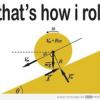 Latest Entry
Latest Entry
Update: A Stephen Hawking Perspective on Wormholes
 During my pursuit of wormhole knowledge, I came across an article by Stephen Hawking discussing his research and opinions on wormholes and travel. I actually found the article quite interesting (and even humourous!), and felt that his findings should yield a separate blog post.
During my pursuit of wormhole knowledge, I came across an article by Stephen Hawking discussing his research and opinions on wormholes and travel. I actually found the article quite interesting (and even humourous!), and felt that his findings should yield a separate blog post.While Hawking definitely believes the data that wormholes exist as a connection between different parts of spacetime, he definitely does not believe in time travel using these wormholes... ever. He states that most wormholes are only billionths or trillionths of centimeters long, not nearly large enough to fit a human, let alone an entire space crew. Wormholes are far too unstable to enlarge by any means, he believes, and even if humans could create a wormhole, it would be far to unstable to leave open long enough to travel through.
Stephen Hawking is also a strong believer in paradoxes. He believes paradoxes caused by wormhole travel are one of the major reasons it could never work, even if the wormhole was large and stable enough to travel through. His example demonstrating paradoxes in wormhole travel involved a scientist looking back at himself minutes earlier through a wormhole; if he decided to shoot himself, who would be the one shooting? It would be a paradox. And this type of paradox is why time travel through a wormhole could not work. It would violate the very theory that cause comes before effect, the theory that governs the universe. In the end, the universe would descend into chaos if time travel through worm holes was possible. And according to Murphy's Law, if that could happen... it would.
Hawking also points out that feedback would prevent wormholes from long term existence. As a wormhole expands, it would suck in more natural radiation, which would create a loop of radiation absorption that would eventually cause the wormhole to collapse.
However, Hawking does see time travel using a black hole as a more possible alternative (although not entirely possible). At the center of the galaxy lies a supermassive black hole, and the gravitational pull around it is so strong that it slows time around it. Flying a space ship around the black hole would cause time to move substantially slower for passengers, which would make the crew travel into the future as they return to Earth. However, it is difficult to do so because the ship would have to travel the speed of light to avoid being sucked into the black hole, which is 2,000x faster than the fastest human space travel. If this were possible, however, there would be no paradox.
Space travel is quite the debated topic in the science community! I will leave the link at the bottom, since it is an excellent article with some fascinating information! Until next time, Fizzix communtiy, until next time.
http://www.dailymail.co.uk/home/moslive/article-1269288/STEPHEN-HAWKING-How-build-time-machine.html
- Read more...
-
- 0 comments
- 26
-

- 30
entries - 8
comments - 9483
views
Recent Entries
 Latest Entry
Latest Entry
Potato Battery

Building a potato (or lemon or apple) battery reveals a bit about the inner workings of electrical circuits. To do this simple science experiment, you insert two different metallic objects often a galvanized (zinc-coated) nail and a copper penny into the potato, and connect wires to each object with alligator clips. These wires can be attached either to the two terminals of a multimeter (which measures a circuit's voltage) or to something like a digital clock or lightbulb. (It may take two or three potatoes wired in series to generate enough voltage to power those devices.)
The potato acts like a battery, generating a current of electrons that flow through the wire. This happens because acid in the potato induces a chemical change in the zinc that coats the nail. The acid acts as an "electrolyte," ionizing the zinc atoms by stripping two electrons from each of them and leaving them positively charged. Those electrons are conducted away from the zinc ions through the wire and through whatever devices lie along the circuit and end up at the copper penny. From there, they join up with positive hydrogen ions in the potato starch that have been repelled there by the nearby zinc ions. The movement of these electrons is enough to power a toy clock or light bulb.
- Read more...
-
- 0 comments
- 30
-

 Latest Entry
Latest Entry
Fun with Shapes in the Universe!
Or more like shape OF the universe! The only book I read anymore is The Cosmic Cocktail by Katherine Freeze, and one topic she came upon was the shape of the universe.
This topic is a very hard one to think of in your head, because its hard to imagine a universe in which we live in expanding! Yet as I showed in another blog post, Hubble himself showed that it must be expanding since galaxies are growing farther away from us!
So then what just shape are we expanding from?? Or Into??? Well there are three options we have. If the density of the universe is less than the critical mass density (found in proportion to the square of Hubble's constant then we are left with a negatively curved geometry, like a saddle. If it matches the mass found from Hubble's constant than we are left with a flat geometry like a piece of paper. But if the density is greater than the one we expect, we are left with a spherical geometry.
Flat geometry is the one Einstein preferred because is it easiest to work with a flat axis instead of a curved one. The effects of these different geometries are interesting though. For example, if the universe was spherical than there would not be enough mass (and density) so after expanding a "Big Crunch" will occur after the Big Bang and the universe will collapse on itself. The other two options are not AS sad though. The flat and hyperboloid geometries on the other hand will continue to expand forever! This will lead to a big chill since the universe will be so expansive and will never stop. I did say as.
The obvious evidence points to flat, the simple answer. It has good evidence behind it though, if the universe was spherical the "Big Crunch" would have happened extremely soon after and there would not have been enough time for the galaxies and such to form! Also a hyperboloid geometry would have led to a much faster expansion than seen a the "Big Chill" would have lead to the same result.
The numerical evidence behind flat geometry is iffy at best though, and is also very complicated, so stay tuned for next time when you can decide for yourself if our universe is like a pancake or a basketball!
-

- 6
entries - 8
comments - 1626
views
Recent Entries
 Latest Entry
Latest Entry
Uh-Oh.
This past March, scientists watched a Black Hole devour a star. It's roughly ten times the diameter of our Sun, but has about 8 million times the Sun's mass. NASA scientists recently made a great animation of what they saw for us mere mortals that have no idea what the people staring through the telescopes are talking about.
As for the unfortunate star, when it entered the black hole the energy in the star swirled around the black hole, forming a disc of light at millions of degrees and spinning at near the speed of light. The blast seen in the animation began at moving roughly 90% of the speed of light. The energy for this requires roughly one octillion (1,000,000,000,000,000,000,000,000,000) tons of matter moving at over 100,000 kilometers per second.
"There are more things on heaven and earth, Horatio, then are dreamt of in your philosophy."
http://blogs.discovermagazine.com/badastronomy/2011/08/26/star-eaten-by-a-black-hole-still-blasting-away/
- Read more...
-
- 0 comments
- 6
-

- 42
entries - 47
comments - 12976
views
Recent Entries
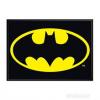 Latest Entry
Latest Entry
Physics of Surviving E&M
So, I am aware that you guys have been doing E&M for a while, so while this is a little late, it should still help. Now, I know that not everyone likes E&M (just ask Mr. Fullerton how much I liked it
 ). Well, I too am taking E&M (for the third time), and I have finally cracked the code for success (took me long enough). Now I, the girl who cannot do the right-hand rule (still), is not only understanding E&M, but solving it CORRECTLY.
). Well, I too am taking E&M (for the third time), and I have finally cracked the code for success (took me long enough). Now I, the girl who cannot do the right-hand rule (still), is not only understanding E&M, but solving it CORRECTLY.How you ask? Well, here are some tips:
1. Don't read the book. Seriously. People who say they read the book and found it helpful either a) didn't read the book b ) are lying or c) is Mr. Fullerton. Instead, DO THE PRACTICE PROBLEMS. The book has some really good example problems that are similar to the ones you do in class, but different enough for practice, and then you have the step by step answers. Plus, some of the examples are actually the derivations for electric fields, and trust me, it's a good idea to do those again.
2. Ask questions. Think you understand what you did in class? Think again. Very few people that I know understood E&M perfectly the first time. Mr. Fullerton doesn't bite, so ask him questions. (The worst that he will do is throw you out a window
 )
)3. Actually do the homework. I mean do the homework on your own, not do the homework with the answer right in front of you so you can glance at it for every step or copy someone else's procedure and plug in your numbers. You may think, Oh, I'm not going to do that. I will only look at the answer key when I need to. I know. I was you. But I stopped doing that because I realized that I was looking at the answers too frequently for it to be MY work. Now I'm not saying don't use the answers. I love answer keys (just ask Mr. Muz). But don't become so dependent on them that you can't solve the problem on your own.
4. Ask for help. The most important of them all. If you need help, you are not going to learn anything by ignoring it, hoping it goes away. In E&M, your worst nightmares never just "go away". They linger in the background and attack when you least expect it, causing you to have a mini breakdown. I know. I've been there. Two days ago. But then I went to my professors office hours and it turned out I knew more than I thought. Shocker, I know.
These things have helped me to survive E&M (barely). And if I can survive, so can you.
PS: Since I am taking E&M this semester, I will post helpful tips, problems, derivations, equation dumps, anything that I think might help you, the new Physics C students, to survive... As long as I have time. I do have my own homework.

- 42
-

- 42
entries - 32
comments - 10930
views
Recent Entries
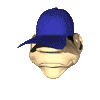 Latest Entry
Latest Entry
Year in review and off to College
Our year has come to an end. College is in the near future and rapidly approaching with each passing hour. At the beginning of the year, I walked into physics c excited but not really sure what to expect nor was I sure how difficult the material would be. As the year progressed, I realized that the tests were hard and I needed to study harder than I ever needed to before. After I failed two out of the first four tests, I was motivated to do well on the next one. The first rotational exam came and I got the highest grade in the class. I proved to myself and my classmates that I could excel if I put the work in. The rest of the year I did decently on the remaining tests and spread my attention towards my other AP classes as well. Electrostatics and magnetism in the second half of the year was very difficult for me. I tried extremely hard to grasp the vague concepts; visualizing the actions of subatomic particles was difficult but by the time the AP exam came, I felt like I understood it better than I ever had. Going into college, I hope to take more physics courses because it intrigues me. But at the same time, I will also take the lessons I learned with me: don’t procrastinate, read the text book, ask a lot of questions, and take the initiative to study a little each night before each test so I don’t stress myself out and go into each test confident and prepared. College will be hard but I am ready to work hard in order to achieve the success I envision. I will discover the cure for cancer, buy my physics c teacher a silver Porsche, and I am ready to take the next step in education and in life.
- 42
-

- 20
entries - 23
comments - 7883
views
Recent Entries
Latest Entry
the end
i thought because i started my bloggery with a prediction and outlook of the course, that i should end it all with an analysis of the year. my thoughts on Mr. Fullerton as a teacher are that he is great at explaining things, and teaching in general. the course is very difficult, and he makes it easier to handle. i also think independent units are a good thing, and that they should be continued. as for blogs, i definitely think writing can help cement understanding of physics concepts, however my opinion is that there are less painful ways of doing so than writing blogs. although I only took half a year of calc, i found the material i learned in that half was more than enough to carry me through this course, yet a whole year would have probably provided me with an even better understanding of this material. i think there should be more projects, contests at the end of the year, and less kerbal, although the kerbal program was extremely educational and interesting, so the best thing may be a balance of the two. all in all, its over and im looking forward to college.
- 20
-
Recently Browsing 0 members
- No registered users viewing this page.










